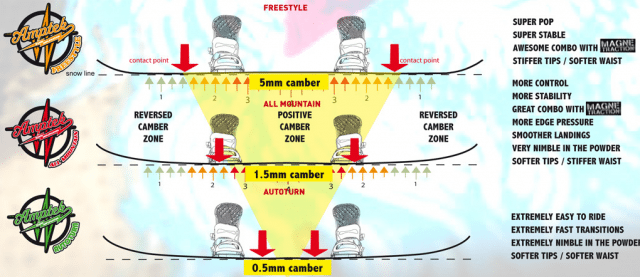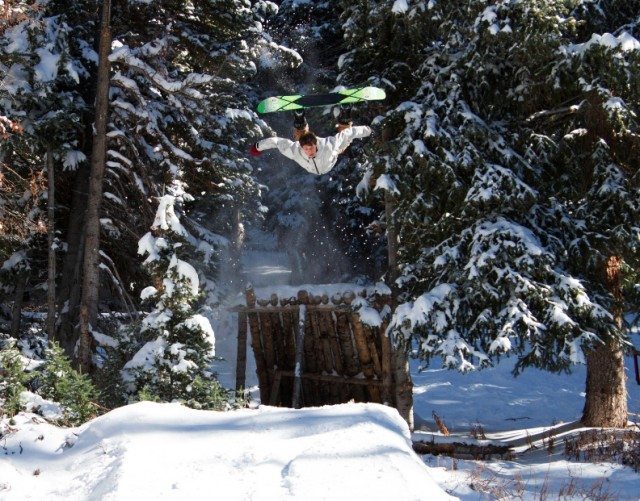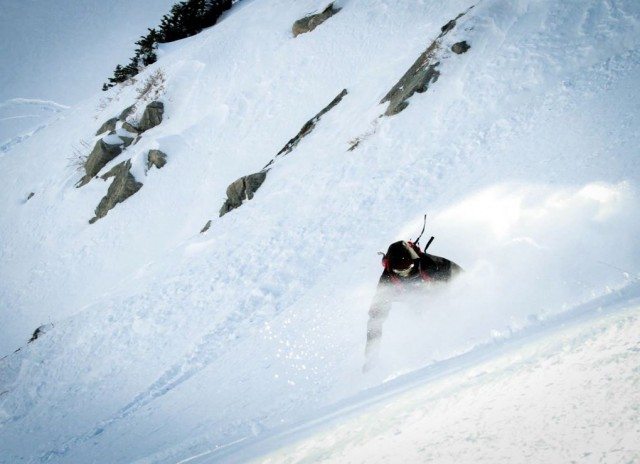
Rossignol Jibsaw MagTek, 157cm
Dimensions (mm): 297,253,297 “True Twin”
Setback: 0mm
Flex: 7/10
Bindings: Burton Malavita
Boots: Burton Ion
Stance: 23.5in
MSRP: $419
Reviewer Info: 6’2″, 170 lbs.
Days Ridden: 12
Locations Tested: Guardsmans Pass, Little Cottonwood Canyon, Park City Mountain Resort, UT
The Jibsaw is Rossignol’s top-tier park and freestyle board, and it features, according to the company, “explosive pop and stability.”
I knew I would need a board for early season rail and park riding, and I was looking for a shorter board with more flex. I tend to choose stiffer boards better suited for pipe and big jumps, so the softer Jibsaw was a different experience for me.
Fit / Sizing
I generally ride a 158cm for jumps and a 161cm for powder, and I chose the 157cm Jibsaw knowing I would primarily use it for riding early season conditions and park. And for these conditions, I knew the true twin-shaped board would suit me best.
I checked Rossignol’s website, and found that the company recommends the 157cm board for people who weigh between 130-200 lbs. Hmmm, that’s a seriously broad range. I weigh 170lbs., and I found that the 157 Jibsaw excelled on rails (more on that in a bit), but I think I would have been better served with the 159cm for big jumps.
Performance
Out of all Rossignol’s boards that have AmpTek rocker, the Jibsaw features the most camber. With a 5mm camber rise in the center, the Jibsaw has 40% rocker / reverse camber and 60% traditional camber, according to Rossignol. The rockered tip and tail let the board press easily on rails while also providing float in pow, and the camber helps with edge hold and stiffness. Both are crucial characteristics of any board I’d consider taking in the park or the pipe.

In Little Cottonwood’s pre-season conditions, I found I much preferred the Jibsaw with its AmpTek Freestyle camber over a board with reverse camber throughout. Even though they’re great in powder, full reverse camber or rocker boards often don’t have great edge hold and suffer on hard pack or chunder.
I wanted to test how the Jibsaw performed around the mountain, and my experience proves what I’d suspected from the start: the Jibsaw is best suited to the park, even though it is better than a full reverse camber board when conditions get choppy. The Jibsaw was too soft for a steep chute with variable conditions I rode at Alta. The board bounced around easily and it wasn’t stiff enough to pin through chunder—not surprising, since the board isn’t intended for this kind of riding anyway.
But I also rode the Jibsaw in the infamous Bonezone, which has plenty of log jibs, handrails, and gap jumps through the trees. Since it’s a true twin and it has a low swing weight, the nimble Jibsaw was quite happy here playing on the kinks, tree gaps, and wallrides scattered throughout the area.

When I took it to the park at Park City, the board exhibited the same characteristics—it was poppy and easy to spin, and overall fun to ride thanks to its soft flex and playfulness.
The Jibsaw is quite possibly the best board I’ve ever ridden for rails.
It’s poppy and lightweight, and it let me 270 on and off in every direction with ease. Rossignol claims this board ranks as a 7 out of 10 on their stiffness / flex scale, but I would rank it far lower than that. The Burton Easy Livin’ could be regarded as a relatively stiff board, but not the Jibsaw in my opinion. The Jibsaw, while not a noodle, isn’t stiff when you compare it to other core pipe / park boards (e.g. Lib Tech Travis Rice, YES ASYM).
And this is a good thing, since it makes pressing through rails a joy, and I can lock in and hold a sustained press through a kink or down bar easily.
Magne-Traction
The Jibsaw uses Magne-Traction 7S, which features 50% smaller Mag bumps than the previous version. In my opinion, Magne-Traction definitely helps with (and certainly doesn’t detract from) my riding.
In the early days of Magne-Traction (essentially wavy bumps on each of the board’s edges), some riders worried that it would catch on rails, but I haven’t found that to be the case. On hard-pack, it grips the snow better, and on rails, it doesn’t affect my riding at all. Still doubtful? You can watch Lib-Tech riders Jesse Burtner or Ted Borland in the Think Thank movies as they slay rails on boards with Magne-Traction.

Bottom Line
The Jibsaw is described as a “true-twin designed for full-throttle park and pipe performance,” but I think it’s best suited for rails.
If you’re looking for a board to blast pipe airs and provide stability on 70-foot jumps, you might want a stiffer—or at least longer—board. But if you want to lock into 5-0’s and press through the kink, definitely check out the Jibsaw. When I hit up smaller jumps or rails, the Jibsaw is the board I now grab 100% of the time.

Hi, I just started riding this season, been about 15 times so far, just learned how to carve on a 2006 rossignol district, it’s a traditional camber board. I’m thinking of upgrading because I feel the board is not very stable at speed over 65km/h and slightly choppy conditions. I’ve been looking for a board that can carve really well at relatively higher speed, able to ride icy, choppy terrain and I want to learn some ground tricks like butter, jumps, ollies 180s. I was about to get this jibsaw until I saw ur review. Is there other choices that would better fit what I’m looking for?
I also looked at Salomon Assassin, Sabatoge, Rossignol Templar, Rome Reverb and Nitro Pyro. I know they are all different boards, just don’t know which one fits my needs best. Appreciate the insight!